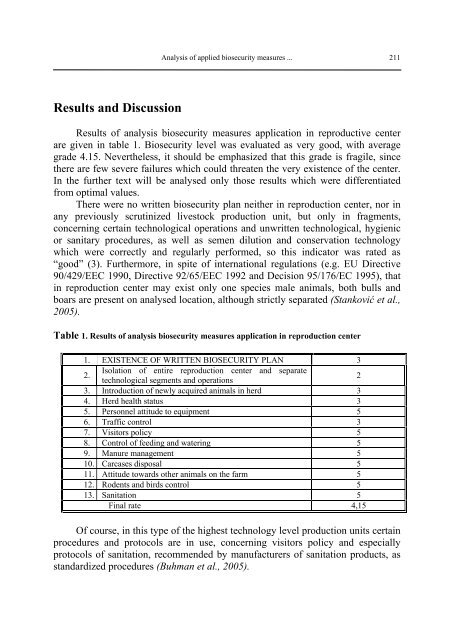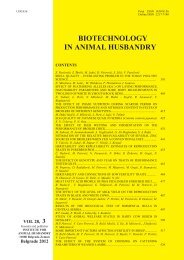Biotechnology in Animal Husbandry - Institut za Stočarstvo
Biotechnology in Animal Husbandry - Institut za Stočarstvo
Biotechnology in Animal Husbandry - Institut za Stočarstvo
You also want an ePaper? Increase the reach of your titles
YUMPU automatically turns print PDFs into web optimized ePapers that Google loves.
Results and Discussion<br />
Analysis of applied biosecurity measures ...<br />
Results of analysis biosecurity measures application <strong>in</strong> reproductive center<br />
are given <strong>in</strong> table 1. Biosecurity level was evaluated as very good, with average<br />
grade 4.15. Nevertheless, it should be emphasized that this grade is fragile, s<strong>in</strong>ce<br />
there are few severe failures which could threaten the very existence of the center.<br />
In the further text will be analysed only those results which were differentiated<br />
from optimal values.<br />
There were no written biosecurity plan neither <strong>in</strong> reproduction center, nor <strong>in</strong><br />
any previously scrut<strong>in</strong>ized livestock production unit, but only <strong>in</strong> fragments,<br />
concern<strong>in</strong>g certa<strong>in</strong> technological operations and unwritten technological, hygienic<br />
or sanitary procedures, as well as semen dilution and conservation technology<br />
which were correctly and regularly performed, so this <strong>in</strong>dicator was rated as<br />
“good” (3). Furthermore, <strong>in</strong> spite of <strong>in</strong>ternational regulations (e.g. EU Directive<br />
90/429/EEC 1990, Directive 92/65/EEC 1992 and Decision 95/176/EC 1995), that<br />
<strong>in</strong> reproduction center may exist only one species male animals, both bulls and<br />
boars are present on analysed location, although strictly separated (Stanković et al.,<br />
2005).<br />
Table 1. Results of analysis biosecurity measures application <strong>in</strong> reproduction center<br />
1. EXISTENCE OF WRITTEN BIOSECURITY PLAN 3<br />
2.<br />
Isolation of entire reproduction center and separate<br />
technological segments and operations<br />
2<br />
3. Introduction of newly acquired animals <strong>in</strong> herd 3<br />
4. Herd health status 3<br />
5. Personnel attitude to equipment 5<br />
6. Traffic control 3<br />
7. Visitors policy 5<br />
8. Control of feed<strong>in</strong>g and water<strong>in</strong>g 5<br />
9. Manure management 5<br />
10. Carcases disposal 5<br />
11. Attitude towards other animals on the farm 5<br />
12. Rodents and birds control 5<br />
13. Sanitation 5<br />
F<strong>in</strong>al rate 4,15<br />
Of course, <strong>in</strong> this type of the highest technology level production units certa<strong>in</strong><br />
procedures and protocols are <strong>in</strong> use, concern<strong>in</strong>g visitors policy and especially<br />
protocols of sanitation, recommended by manufacturers of sanitation products, as<br />
standardized procedures (Buhman et al., 2005).<br />
211




